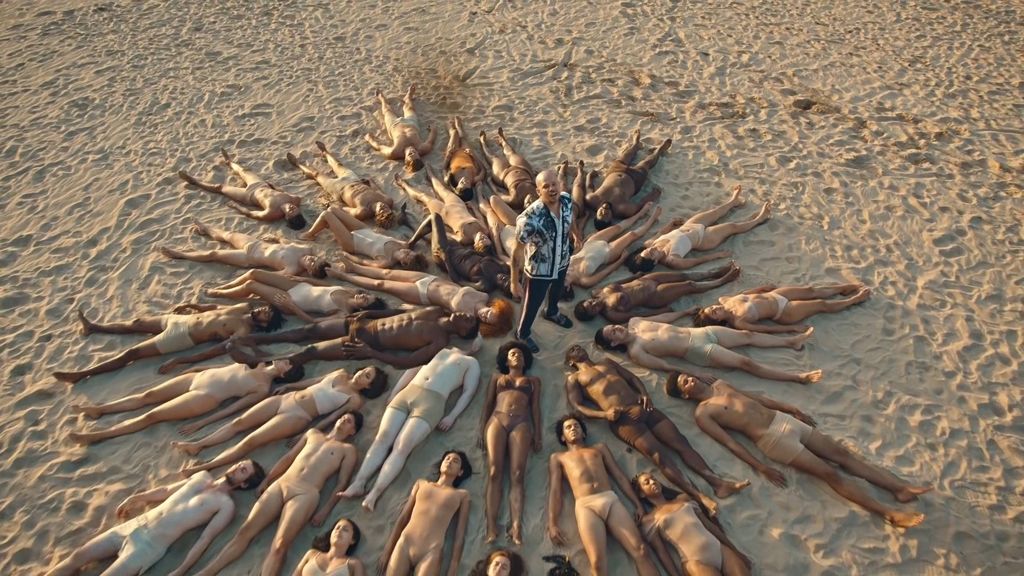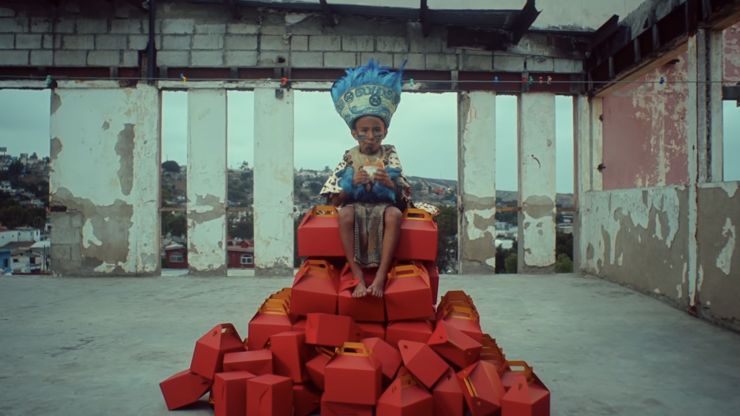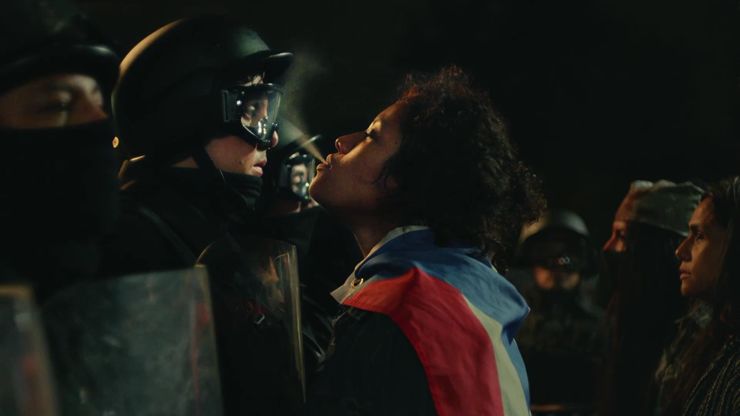)
Gregory Ohrel: Provocateur with purpose
Kicking off January's Music Video Focus, Selena Schleh speaks to Gregory Ohrel, whose brutal, incendiary and stimulative promo for Puerto Rican rapper Residente’s protest track, This Is Not America, provoked deeper thought on the nature of nationalism.
Once every few years, a music video comes along that gets the whole world talking. In 2018, that video was Childish Gambino’s This Is America.
Shocking, original, and smart, it juxtaposed casual violence with layers of symbolism to spotlight institutionalised racism in the US. It’s apt, then, that this year’s most talked-about music video – for Puerto Rican rapper Residente’s track, This Is Not America – is a sequel and riposte to the original provocative promo.
It is similarly laden with retina-searingly brutal imagery but while its forerunner focused on the Black experience, This is Not America targets US imperialism and the way the country has systematically exploited and oppressed Latin America – right down to the level of language. You can practically feel the steam coming off Residente as he raps about the arrogance of conflating ‘America’ with the United States, when in reality, it “extends from Tierra del Fuego to Canada.”
People have been extremely proud, and moved, to see their countries represented.
“That was one of the main points of the video, to remind people that America is not just [the US], but a whole continent,” says the film’s director, Gregory Ohrel. “I’ve watched almost a hundred ‘reaction’ clips, and lots of people from the US were agreeing, saying ‘it’s narrow-minded to call ourselves American, we should call ourselves something else’. So that is a real victory for me and Rene [Residente].”
Most people would also count a Grammy nomination, two AICP awards and a Grand Prix for Entertainment Lions for Music at Cannes among their ‘victories’, yet it’s clear that Ohrel is far more interested in public reaction than trophies – particularly across Latin America, where “people have been extremely proud, and moved, to see their countries represented.”
Credits
powered by
-
- Production Company Doomsday Entertainment
-
-
-
Unlock full credits and more with a Source + shots membership.
Credits
powered by
- Production Company Doomsday Entertainment
- Producer Jason Cole
- Producer Danielle Hinde
- Producer Corinna Martinez
- Executive Producer Jason Cole
- Editor Arianna Tomasettig

Credits
powered by
- Production Company Doomsday Entertainment
- Producer Jason Cole
- Producer Danielle Hinde
- Producer Corinna Martinez
- Executive Producer Jason Cole
- Editor Arianna Tomasettig
Ohrel says that as a "gringo director", the prospect of tackling such pivotal, politically sensitive moments in history and authentically conveying the Latin American experience was “an intense pressure on my shoulders.” Knowing that many of the references – such as the dramatic opening scene where a glamorous woman fires rounds into the air outside an official-looking building, in a clear nod to Puerto Rican freedom fighter Lolita Lebrón – would be instantly recognisable to a Latin American audience, he “didn't want it to feel like I was watching the situation from a distance and looking at it with European eyes, so I took it very seriously and really did my research. The details and the characters had to be really accurate, right down to the costumes.”
I didn't want it to feel like I was watching the situation from a distance and looking at it with European eyes
The director was also cautious about framing the video as a response to This Is America, so it helped that Doomsday Entertainment produced both films. “That made it possible for us to answer This is America without attacking Childish Gambino – which wasn’t the idea, we love his work. It was meant to be a peaceful and interesting reply to the first music video.”
Violence was the defining feature of This Is America, and dominates the new video too, albeit filtered through a prism of protest: riot shields, tear gas, defiant mobs facing off against the police, tribal woman pairing their traditional garb with ski masks and guns – intercut with subtler messages of resistance, including an indigenous child toting the elaborate feathered headdress of Aztec emperor Montezuma, standing on piles of Starbucks cups and Amazon boxes, reminiscent of a pyramid of skulls.
Some scenes – such as a beaten-up musician being unceremoniously shot through the head, referencing the assassination of Chilean singer Victor Jara by Pinochet’s regime; or the closing images, where the camera pans out to reveal the bloodied corpses of protestors spelling the word ‘America’ – are genuinely horrific, but Ohrel also captures moments of unexpected beauty amidst the brutality: a pair of lovers dancing the tango on a burning street; a mother breastfeeding her baby through the chain-link fence that separates them at the border; fearsome tattooed Salvatruchas (Salvadorean gangsters) finding God at the ocean’s edge. “That was very important to me: I didn’t want to show Latin America as somewhere that is totally fucked up and dark. Yes, there is lots of violence, there's lots of things going wrong, but you can also find redemption in all this chaos.”
I didn’t want to show Latin America as somewhere that is totally fucked up and dark.
Ultimately, the overriding message of the film is resistance, as French-Cuban duo Ibeyi sing on the chorus: “Here we are/ We are always here/ We didn’t leave/ We’re not leaving/ Here we are to remind you that if it wants to/ My machete will bite you” - a refusal to succumb to capitalist greed and injustice, a spark of hope which was entirely absent from This Is America. It’s this theme which offers universal appeal, says Ohrel: “I knew I wanted to make a music video that was going to touch people around the world, not just Latin America. Someone from Sweden or Russia isn’t [necessarily] going to recognise the little details, the historical aspects, but they’ll hopefully still be affected by it.”
Credits
powered by
-
-
- Director Hiro Murai
-
-
Unlock full credits and more with a Source + shots membership.
Credits
powered by
- Director Hiro Murai
- Post Production MPC/Los Angeles

Credits
powered by
- Director Hiro Murai
- Post Production MPC/Los Angeles
Above: This Is America, Childish Gambino's 2018 smash.
With its heavy political ambitions and undercurrent of anger, This Is Not America is a radical departure from Ohrel’s usual style, which tends to go heavy on complicated in-camera tricks and inventive VFX. He started his directing career as one half of a duo, Greg & Lio, who built their reputation with energetic films full of eye-popping transitions, distortions and perspective shifts – as seen in the MVA-nominated Jain Makeba, the Latin Grammy-winning Jaunes Pa Dentro, and two stunning single-take videos for French rapper Orelsan.
By 2019, despite finding success in the music video world, the pair decided to go their separate ways – Lio to pursue his dream of making shorts and a feature film, Ohrel to continue his passion for promos. “I felt at that time that I still had a lot of things to say through music videos,” he muses. “I love the way they give you the possibility to tell your story [as a director], by using the music of an artist as a base.”
I love the way [music videos] give you the possibility to tell your story [as a director], by using the music of an artist as a base.
Since forging his solo career, Ohrel has noticed his aesthetic beginning to change. “The first videos I shot were very different – they were much brighter, happier. I don't know why, but I'm starting to be more and more attracted by these kinds of darker images. When you are in a duo, your personality is melted into something shared, and you create a new monster out of the two personalities. I’m not killing the monster because it's still part of me, and I still love very lively, cheerful, characterful stuff. But there is another part of me which is showing itself little by little every day.”
A case in point was his first collaboration with Residente, on Bellacosa featuring Bad Bunny. On the surface, the video is vintage Greg & Lio, but look closer and you’ll spot a few leftfield additions, like the twerking tanned backsides which reveal themselves as belonging to transgender people, rather than hot girls. “It’s these little details - playing with what people are expecting in this kind of music video and switching it into something a bit different – that I like to include, and they’re only possible with someone like Rene who was very open-minded. I knew then that for our next project, we could take things in an interesting direction.” That next project turned out to be a video for Residente’s “very political, very intense” new track, and though it had no title and only half the lyrics, Ohrel knew “it would be amazing”. The rest is history.
Credits
powered by
-
- Production Company Doomsday Entertainment
- Director Gregory Ohrel
-
-
Unlock full credits and more with a Source + shots membership.
Credits
powered by
- Production Company Doomsday Entertainment
- Director Gregory Ohrel
- Executive Producer Danielle Hinde

Credits
powered by
- Production Company Doomsday Entertainment
- Director Gregory Ohrel
- Executive Producer Danielle Hinde
Above: Bellacosa, Ohrel's first collaboration with Residente.
After the runaway success of This Is Not America, what’s next for Ohrel? More meaningful briefs, he hopes: “I'm starting to get bored with playing around with camera tricks. To be perfectly honest, when you do something impressive with camera movement, most people don't really care about it – yes, it’s going to impress DOPs and other directors… but I want my work to move everyone, not just people from our industry.” He’s excited about the potential of music videos as a medium for change. “It got me thinking, there are so many music videos that are just entertainment, and so few which are really trying to spread a message and be political. So that’s something I want to do more of.”
There are so many music videos that are just entertainment, and so few which are really trying to spread a message and be political.
True to his word, he’s managed to hide a series of political Easter eggs within his latest piece of work, Nsera, for Malian artist Fatoumata Diawara and Gorillaz’ Damon Albarn. A vibrant celebration of Mali’s culture, people and landscapes, the Afrofuturistic video also references child soldiers, neo-colonial violence and – chillingly represented by a football dripping with blood - the modern slavery accusations underlying this year’s World Cup in Qatar.
“I’ve shot a lot of commercials in South Africa and always been kind of sad not to have a deeper understanding of Africa,” explains Ohrel. “So this is a very African music video – the casting, the outfits that Fatoumata is wearing, the references to some of my favourite photographers like [Ghanaian visual artist] Prince Gyasi. There are lots of little details that only an African audience will spot – like in This Is Not America.”
With that meticulous commitment to authenticity and endless inventiveness and a new, purpose-driven ethos, the next chapter of Ohrel’s directing career looks like an exciting one.
This Is Not Greg & Lio - This Is Gregory Ohrel.
)
















